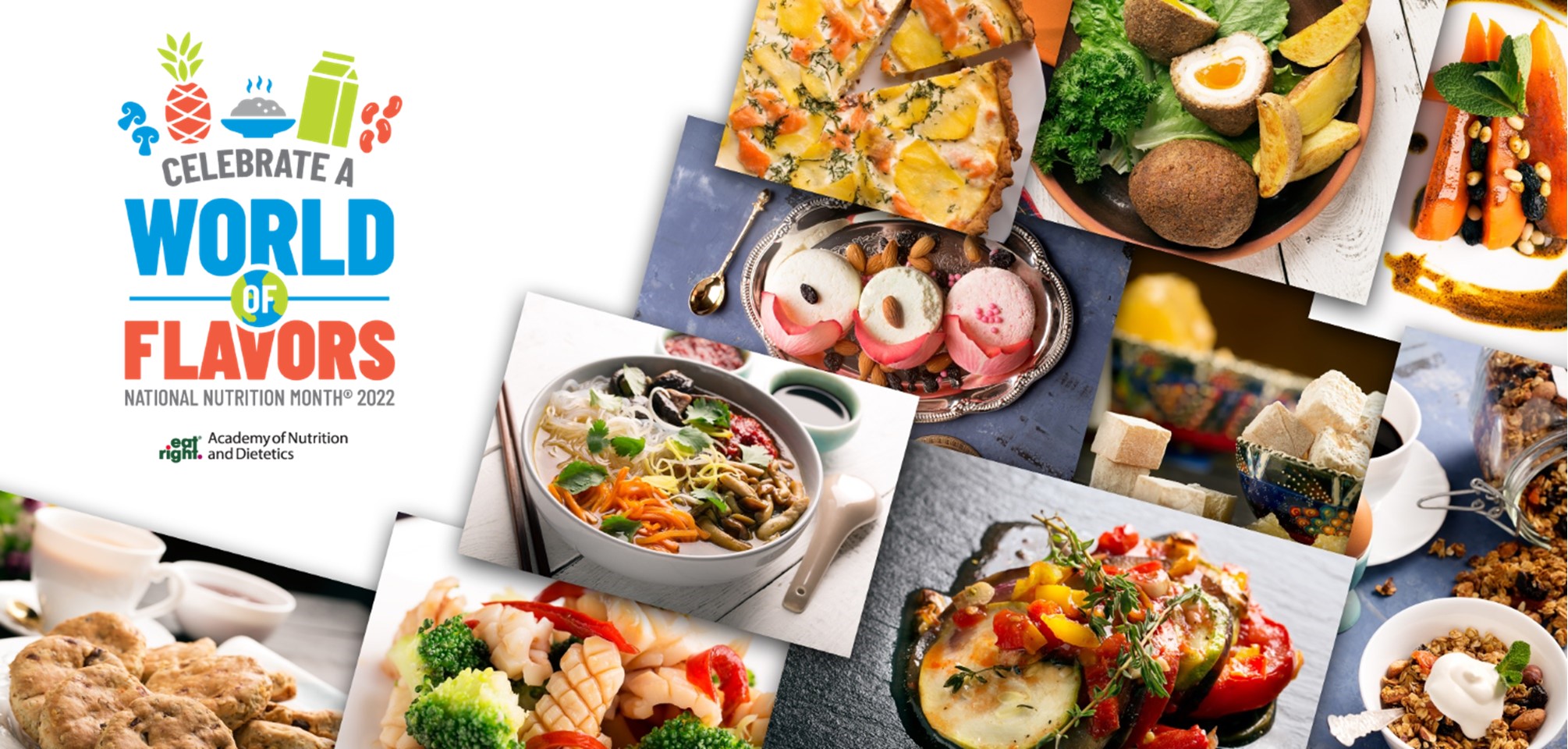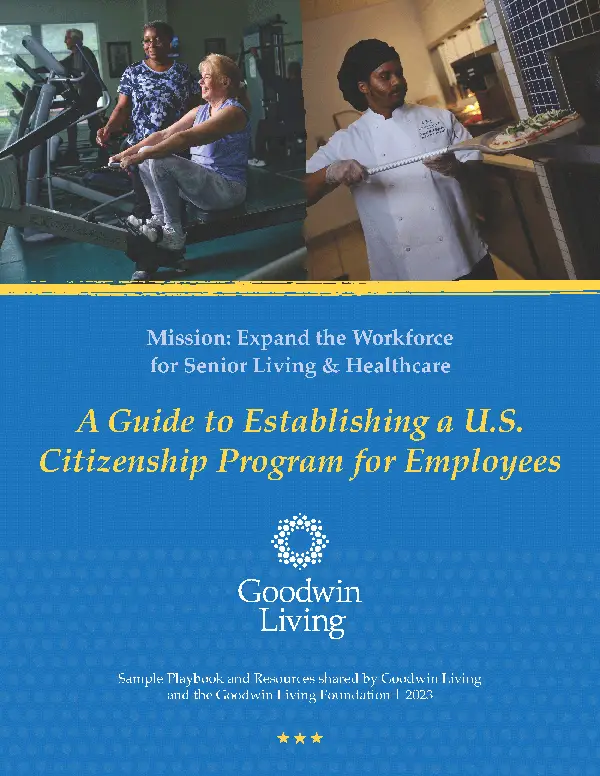
Live Vibrantly - March 23, 2022
By Amanda Ranowsky
It’s time to celebrate a world of flavors!
At Goodwin Living, celebrating the uniqueness and diversity of every member of our greater community is one of our core values. As part of this celebration, we showcase the many different food traditions of residents, members and staff in the meals we serve at Goodwin House Alexandria and Goodwin House Bailey’s Crossroads and special events with Goodwin Living At Home members.
Embracing a variety of foods and cuisines in our diet not only makes our plates more interesting—it’s also good for our health. Just ask Goodwin Living dietitians Alison Liggett Neov, RDN, CSG and Alexandra Freiman, RDN, CSG. As nutrition experts in our Life Plan Communities, they partner with our executive chefs and dining managers to develop the menus for our dining venues and meal services. Together, they ensure that our food options taste delicious while also delivering key nutrients. Alison and Alexandra also work individually with residents who might need more personalized guidance.
March is National Nutrition Month®. Every year, the Academy of Nutrition and Dietetics engages in a concerted effort to encourage people to learn about making informed food choices and develop healthy habits. This year, the theme is “Celebrate a World of Flavors”, a call to recognize, appreciate and embrace our diversity—be it in our bodies, our heritage, our goals or our tastes.
As part of our recognition of this month, we spoke to Alison and Alexandra about some common misconceptions in the field of nutrition and about how they celebrate diversity in the meals served at Goodwin Living.
Alison: There are a lot of guidelines around food, and the images that they show are generally one type of cuisine. It’s known as a Eurocentric lens. You’ll hear about the Mediterranean diet as ideal for health, but you won’t hear the same said about an Indian diet or an Asian diet or an African diet. Why is it that we’re pointing to one specific culture as being the best, when there are different parts of all the foods in other cultures that are healthy and beneficial? I think it’s important for dietitians and for other medical professionals to see the value in a variety of diets from all parts of the world and not get stuck in one way of teaching and one way of thinking.
Alexandra: Often, what we Americans see is the Western version of the cuisine. Let’s take Indian restaurants, for example. My concept of Indian food used to be only the dishes I typically saw in Indian restaurants here in the U.S. Then I had dinner with an Indian friend’s family. Her mom taught us how to cook Indian foods. It was a different variety of vegetables, fish and grains, unlike anything I’d ever had in an Indian restaurant, and recipes that I’d never heard of. She explained that what we have in restaurants is what they would call American Indian food. It’s based upon some real recipes and traditions, but that’s not how people in India eat every day. When we really immerse ourselves in a culture—and not just the Western snapshot of the culture—we get to see the actual benefits of their cuisine.
Alexandra: To call any food “bad” food is a myth. My main thing is, there are no “bad” foods. I prefer to emphasize variety, having different fruits, vegetables and lean meats, with everything in moderation. That’s the most important way to get the nutritional benefits of food while still being able to celebrate diversity or a particular culture.
Alison: I agree. We have to be really cautious about using the words “good” and “bad” around food. I think there is a place for all food in a diet.
One myth I’ve heard is, “if it tastes good, don’t eat it.” That’s something that residents have told me they’ve heard from doctors. I think that’s just an example of poor nutritional counseling. Our food should always taste good. We do not want you to eat food that doesn’t taste good. Taste and flavor: that’s why we live. That’s how we connect with other people.
Alexandra: Depending on what you believe, we have one life to live on this planet. I’m not going to spend it being miserable three times a day eating stuff I don’t like.
Alison: Another myth I hear a lot is “white rice is bad”. White rice is a very traditional food in most cultures. It’s also low in fiber, which can actually be beneficial for some people—there are specific diets where we want something low in fiber.
Alexandra: White rice is a great example. It is a staple for billions of people in the world, and if we as dietitians are telling them “that’s bad for you”, it’s causing people to lose trust and make them feel bad about themselves. And they don’t deserve to feel that way about their food.
Alexandra: Absolutely! One of the things I like focusing on is called the “Blue Zones”, which are areas of the world where people commonly live to be 100 years old. What love about them is that they are not limited to one region of the world. We tend to have this Eurocentric idea of what a healthy diet is, but when you look at this map you’ll see places like Japan and Costa Rica included. While Africa isn’t on that particular list, I do know that there are certain towns and cities in Africa that have some of the healthiest populations in the world. And when you look at what the diets are in these “Blue Zone” areas, you see it’s different for each one.
If you want to see which diets work, check to see who’s living to be 100, because the proof is in the pudding, so to speak.
Alison: Spices in general have a lot of health benefits. If you’re thinking about any cuisine, they’re using so many different herbs and spices, and usually with a strong purpose. I think that’s something that’s really important to keep in the traditions, to have specific spices with specific meals. Turmeric, for instance, is anti-inflammatory, and is a common spice in Indian cuisine, among others.
Alison: Inspiration for our menus starts with the background of our cooks. Many of them come from other countries. They will cook a dish, present it to the chef and ask for it to be on the menu. Other times, our inspiration comes from research or from a holiday celebration. We’re always rotating the different celebrations and holidays that we recognize with special meals so that we can show a lot of different cultures and cuisines and offer a variety of experiences. If we find that everyone likes a specific dish from one of our special meals, it might end up staying on the menu!
We also offer some flexibility in the way a dish is prepared. Residents can choose their spice level, for instance. I think that’s important. If you’re going to have a dish that’s naturally very spicy, that might not be everyone’s interest. We also have action stations where we try to offer one meat or seafood option and one vegetarian or vegan option. That way, whatever your dietary preferences, you can still have a similar experience.
We have a Thai dish right now at Goodwin House Bailey’s Crossroads that’s really popular—one version made with sea bass and green curry, and a vegan option with red curry. It’s such a popular dish that we decided to share it here!
Alexandra: I love how willing residents are to try different things. I’ve worked with older adults my whole life, and for many of them, their idea of ethnic foods was Italian. I wanted to say to them, there are so many good flavors out there that I would love to show you. So my first week here at Goodwin House Alexandria, when I saw that curried veal was on the menu, my heart sang. I thought, it’s so exciting that people would get to try different cuisines and foods and discover that they enjoy them!
Alison: There’s always a way that it can work. It might just be playing with the portion size of the items that you have or adding some additional items. Say it’s in your tradition to eat rice and beans and another starch, but you have issues with your blood sugar. We might give you the recommendation to increase your portion of protein, fat and vegetables at your meal and then slightly decrease the amount of starches. You can also get creative with using different types of foods that offer the same nutrients. For example, if you need to increase your calcium but dairy products are not a strong part of your cultural tradition, there are some vegetables you could add instead that provide calcium.
Alexandra: The building blocks of good nutrition are the same regardless of culture. You want to promote a diet high in fruits and vegetables, lean meats and whole grains if possible. But you have the flexibility to choose what fits within your culture. It’s not a one-size-fits-all model. The important thing is having diversity in your diet, not eating the same things every day, even if you are eating foods common to your culture. If you do feel like trying things outside your comfort zone, do it and enjoy it! I hope you learn from it.
_______________
As Marketing & Communications Specialist, Amanda Ranowsky partners with colleagues throughout Goodwin Living Incorporated to tell our stories and raise brand awareness. From printed collateral to digital marketing, Amanda covers many bases. Before joining GHI, Amanda worked for a small, family-owned business where she gained experience in content marketing. Amanda’s creative expression extends beyond the office. She is an active member of community theater and chorus groups.
